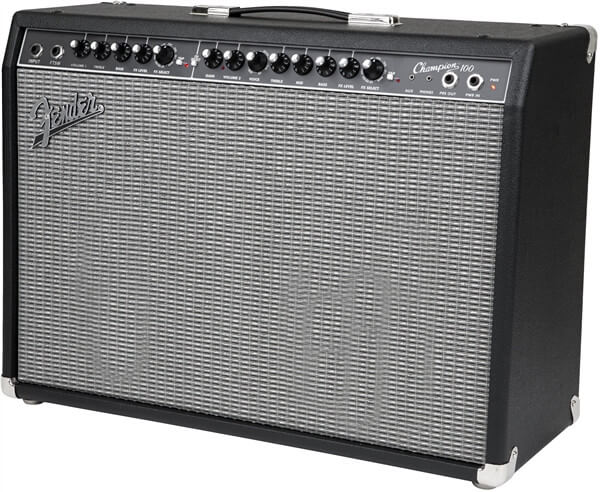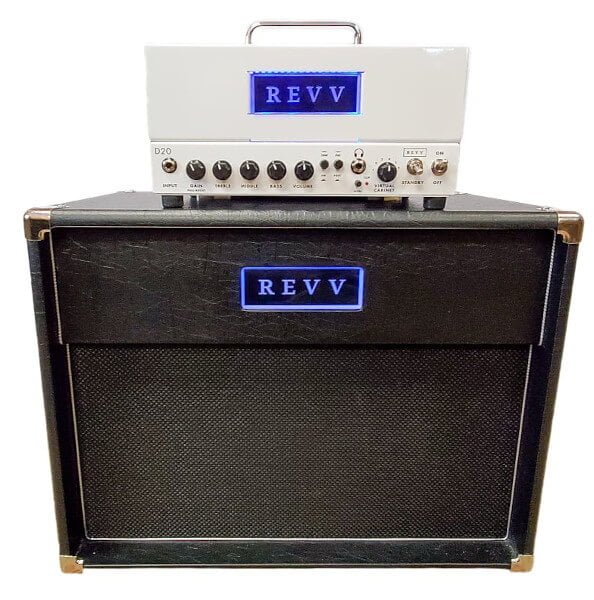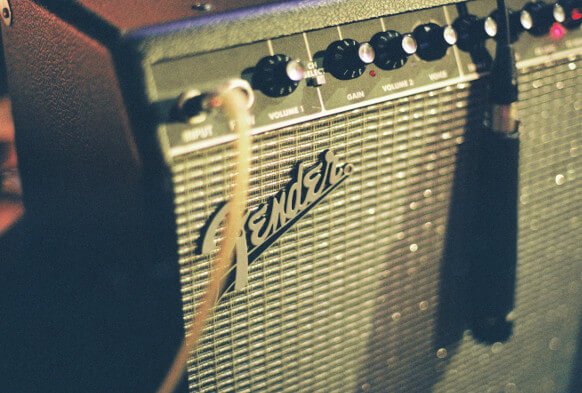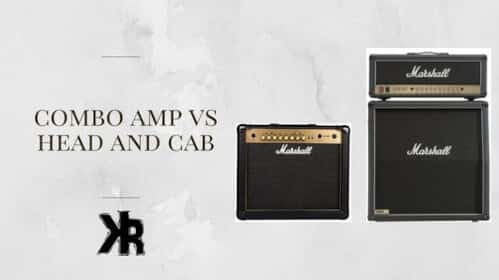Table of Contents
Buying a new amplifier is a great way to get closer to the sound in your head. But with so many available, it’s hard to know which is best for your needs. Like a combo amp vs head and cab, both have their pros and cons.
A combo amp is a combination of an amplifier and speaker all in one. Where a head and cab are two separate devices that get connected together in order to operate.
Choosing the right one depends on the power output you need and the overall weight of your guitar rig.
In this Killer Rig article, we are going to explore both options. All done to see how they differ and which choice might be a good fit for electric guitars.
Main Differences Between Combo Amp vs Head and Cab
The main difference between a combo amp and a head and cab is that one comes with a built-in speaker. A combo amp provides a player with an amplifier and speaker all in one case.
The head and cab are separate products. They need to be connected together in order to obtain the same result.
Combo amps are usually lighter and more portable than head and cab setups. But this all depends on the design.
They’re great for players who move around a lot or need to be able to pack up their gear quickly. On the other hand, head and cab setups offer more power and flexibility.
There are also some visual differences between combo amps and head and cabs. Combo amps often have a more traditional amplifier look. While head and cabs can be more sleek and modern.
What Is a Combo Amp?
A combo is an amplifier that has a speaker built in. That means it’s a one-piece unit with everything you would need for amplification!
As opposed to a head and cabinet, which are two separate pieces of gear that need to be connected together.
Combo amps come in all shapes and sizes. They can have one, two, or even four speakers. They can be as small as a lunchbox or as large as a refrigerator.
These are popular because they’re usually lighter and more portable. Especially when compared to head and cab setups, which is very convenient.
That’s not always the case, though. Some combo amps are heavy and can be cumbersome. This can make them very hard to move around, especially if they have 2 or more speakers.
Combo amplifiers are also popular. This is because they’re usually less expensive than head and cab setups. Although this depends on the manufacturer and the design.
Plus, the number of speakers that are included. But it’s common for players to buy a 22-watt combo and use it as a practice amp.

Pros and Cons of Combo Amps
| Pros | Cons |
|---|---|
| Can be lighter and more portable than head and cab setups. | Might not have as much power as a head and cab setup. |
| Has a more traditional look. | Some combo amps are quite heavy. |
| Less setup required than a head and cab. | Some combo amps can be quite expensive. |
Head and Cab Explained
A head and cab are two different devices. A head is an electric guitar amplifier, while the cab contains the speakers.
They are connected together by using a speaker cable, with the head sitting on top of the cabinet. This is also referred to as a stack.
Head and cab setups offer more power and flexibility than combo amps. That’s because you can mix and match different heads and cabs to get the perfect sound for your needs.
For example, if you’re looking for a lot of power, you could pair a high-wattage head with a 4×12 cabinet. This is referred to as a full stack. Or, if you’re looking for something smaller, you could pair a lower-wattage head with a 1×12 or 2×12 cabinet.
Head and cab setups are also usually more expensive than combo amps. That’s because you’re buying two pieces of gear instead of one.

Pros and Cons of Head and Cab
| Pros | Cons |
|---|---|
| Can offer more power and flexibility than combo guitar amps. | Can be more expensive than combo amps. |
| Allows you to mix and match different heads and cabs to get the perfect sound. | Takes more time to set them up. |
| Looks more modern, which some players prefer. | Can be harder to transport than combo amps. |
How to Set Up a Combo Amp vs Stack
At this point, you might be curious as to how a combo amp and a head and cab get set up.
When it comes to a combo, there is little setup. This is because it includes the speaker and the amplifier. Plus, all the wiring is built into one device!
Simply plug it into the wall outlet to give it power and connect your guitar. In certain cases, you might get a foot switch with it, but otherwise, that’s it.
With a head and cab, there is one additional step. You will need a speaker cable to connect the head to the cab in order to get sound.
But once the head is sitting on top of the cab, and they are connected, then the amp will need power. Also, your guitar must be plugged into the input.
In some cases, you may also use effect pedals. In this case, these devices will also need to be connected to either the input or the effects loop. But this depends on how much gear you use.

Which one should you choose?
The answer to this question depends on what you’re looking for and what’s important to you.
Are you looking for something lighter, and portable that requires minimal setup? Then a combo amp might be the best fit. In some cases, the speaker might not be the best for your sound, but it can always be replaced with something else.
If you need more power and flexibility, then a head and cab setup would be better. It’s also a better option if you like to run more speakers with your head or like different sounds.
This gives you the option to try many different speakers by swapping cabinets. There are also many options to choose from that can help find the right tone.
Another important factor is deciding how you will be using the guitar amp. Are you using it for home practice?
Then you might also consider one with speaker cabinet simulation. Some amps come with speaker simulation built-in and don’t require a cabinet at all.
An example of this is the Revv G20, which is a tube amp head with built-in speaker simulation.
You can play this electric guitar amp without a cab by simply using headphones. Or sending an XLR output to an interface. And the nice thing is that it’s so small that it can just sit on your desk!
Conclusion
There are many factors to consider when choosing between combo amps and head and cabs. It really comes down to what you’re looking for in a guitar amplifier and what’s important to you.
Whatever you choose, as long as it is made by a reputable brand, there is a good chance you will be happy in either case.
If you’re looking for an amp for a bass guitar, then the same applies. Many bass amps come in a combo, as well as head and cab options.
But the cabinet setup may be a bit different, as some of them can have 6 or even 8 speakers inside!
FAQs
Can I Use a Cab With a Combo Amp?
In some cases, this is possible, yes. If your combo amp has been designed to use an external speaker, then you can use a stand-alone cab. But just make sure the impedance is correct between the amp and the cab.
Can you use an amp head with any cabinet?
Yes, as long as the impedance matches, you can use any head with any cabinet. You will also want to make sure the power being put out by the head is not going to damage the cabinet. But this is as easy as keeping the volume level within the limits.
Are combo amps good for gigging?
Yes, combo amps are great for gigging. They are usually lighter and more portable, which is great if you have to move around a lot.
And they don’t require any extra setup. Which can be a lifesaver when you’re trying to get everything set up quickly.
Can you use an amp head with a combo?
Yes, you can! A combo amplifier normally has the speaker connected to the rear. The connection is often visible and easy to get to.
You can simply unplug it from the combo and connect it to the guitar amp head. Just make sure the impedance is correct, or you might do damage.

